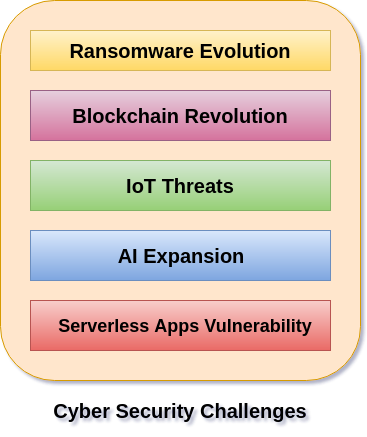Today cybersecurity is the main component of the country's overall national security and economic security strategies. In India, there are so many challenges related to cybersecurity. With the increase of the cyber-attacks, every organization needs a security analyst who makes sure that their system is secured. These security analysts face many challenges related to cybersecurity such as securing confidential data of government organizations, securing the private organization servers, etc.
The recent important cybersecurity challenges are described below:

1. Ransomware Evolution
Ransomware is a type of malware in which the data on a victim's computer is locked, and payment is demanded before the ransomed data is unlocked. After successful payment, access rights returned to the victim. Ransomware is the bane of cybersecurity, data professionals, IT, and executives.
Ransomware attacks are growing day by day in the areas of cybercrime. IT professionals and business leaders need to have a powerful recovery strategy against the malware attacks to protect their organization. It involves proper planning to recover corporate and customers' data and application as well as reporting any breaches against the Notifiable Data Breaches scheme. Today's DRaaS solutions are the best defence against the ransomware attacks. With DRaaS solutions method, we can automatically back up our files, easily identify which backup is clean, and launch a fail-over with the press of a button when malicious attacks corrupt our data.
2. Blockchain Revolution
Blockchain technology is the most important invention in computing era. It is the first time in human history that we have a genuinely native digital medium for peer-to-peer value exchange. The blockchain is a technology that enables cryptocurrencies like Bitcoin. The blockchain is a vast global platform that allows two or more parties to do a transaction or do business without needing a third party for establishing trust.
It is difficult to predict what blockchain systems will offer in regards to cybersecurity. The professionals in cybersecurity can make some educated guesses regarding blockchain. As the application and utility of blockchain in a cybersecurity context emerges, there will be a healthy tension but also complementary integrations with traditional, proven, cybersecurity approaches.
3. IoT Threats
IoT stands for Internet of Things. It is a system of interrelated physical devices which can be accessible through the internet. The connected physical devices have a unique identifier (UID) and have the ability to transfer data over a network without any requirements of the human-to-human or human-to-computer interaction. The firmware and software which is running on IoT devices make consumer and businesses highly susceptible to cyber-attacks.
When IoT things were designed, it is not considered in mind about the used in cybersecurity and for commercial purposes. So every organization needs to work with cybersecurity professionals to ensure the security of their password policies, session handling, user verification, multifactor authentication, and security protocols to help in managing the risk.
4. AI Expansion
AI short form is Artificial intelligence. According to John McCarthy, father of Artificial Intelligence defined AI: "The science and engineering of making intelligent machines, especially intelligent computer programs."
It is an area of computer science which is the creation of intelligent machines that do work and react like humans. Some of the activities related to artificial intelligence include speech recognition, Learning, Planning, Problem-solving, etc. The key benefits with AI into our cybersecurity strategy has the ability to protect and defend an environment when the malicious attack begins, thus mitigating the impact. AI take immediate action against the malicious attacks at a moment when a threats impact a business. IT business leaders and cybersecurity strategy teams consider AI as a future protective control that will allow our business to stay ahead of the cybersecurity technology curve.
5. Serverless Apps Vulnerability
Serverless architecture and apps is an application which depends on third-party cloud infrastructure or on a back-end service such as google cloud function, Amazon web services (AWS) lambda, etc. The serverless apps invite the cyber attackers to spread threats on their system easily because the users access the application locally or off-server on their device. Therefore it is the user responsibility for the security precautions while using serverless application.
The serverless apps do nothing to keep the attackers away from our data. The serverless application doesn't help if an attacker gains access to our data through a vulnerability such as leaked credentials, a compromised insider or by any other means then serverless.
We can run software with the application which provides best chance to defeat the cybercriminals. The serverless applications are typically small in size. It helps developers to launch their applications quickly and easily. They don't need to worry about the underlying infrastructure. The web-services and data processing tools are examples of the most common serverless apps.

No comments:
Post a Comment